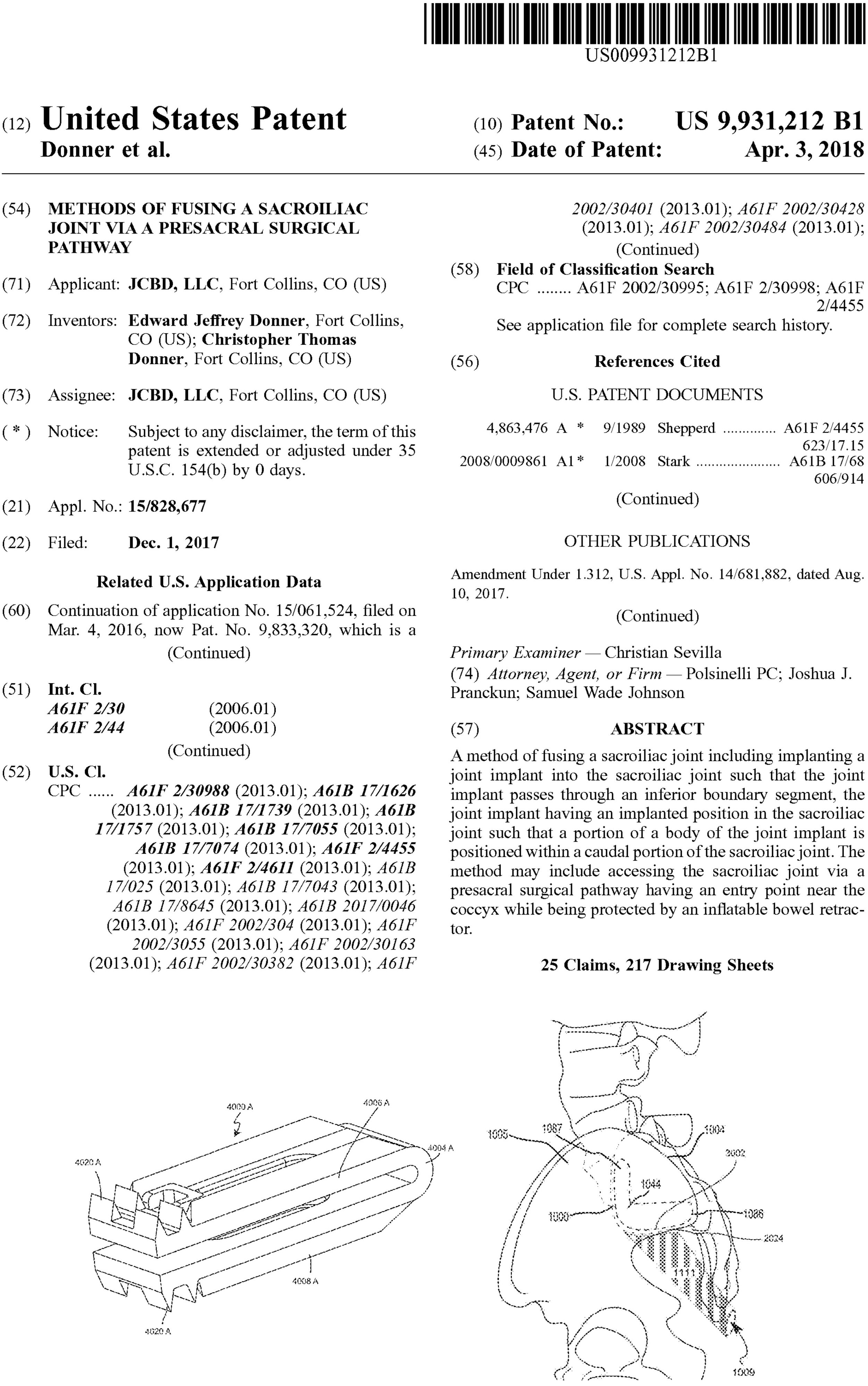US PATENT 9,931,212 B1
METHODS OF FUSING A SACROILIAC JOINT VIA A PRESACRAL SURGICAL PATHWAY
A method of fusing a sacroiliac joint including implanting a joint implant into the sacroiliac joint such that the joint implant passes through an inferior boundary segment, the joint implant having an implanted position in the sacroiliac joint such that a portion of a body of the joint implant is positioned within a caudal portion of the sacroiliac joint. The method may include accessing the sacroiliac joint via a presacral surgical pathway having an entry point near the coccyx while being protected by an inflatable bowel retractor.
CLAIMS
The invention claimed is:
1. A method of fusing a sacroiliac joint defined between a sacrum and an ilium, the sacroiliac joint comprising a sacroiliac joint space boundary outlining a sacroiliac joint articular region, the sacroiliac joint space boundary comprising an inferior boundary segment, an anterior boundary segment, a superior boundary segment, a posterior boundary segment, and a posterior inferior access region, the inferior boundary segment is immediately adjacent, and extends along, a sciatic notch, the inferior boundary segment and anterior boundary segment intersect to form an anterior-inferior corner, the inferior boundary segment and the posterior inferior access region intersect to form an inferior-posterior corner, the inferior boundary segment extends between the anterior-inferior corner and the inferior-posterior corner and provides access into a caudal portion of the sacroiliac joint, the superior boundary segment extends between an anterior-superior corner and a superior-posterior corner and provides access into a cranial portion of the sacroiliac joint, the cranial portion positioned superiorly of the caudal portion, the method comprising:
a) approaching the sacroiliac joint with a joint implant comprising a body extending a length between a distal end and a proximal end; and
b) implanting the joint implant non-transversely into the sacroiliac joint such that the joint implant passes through the inferior boundary segment, the joint implant having an implanted position in the sacroiliac joint such that a portion of the body of the joint implant is positioned within the caudal portion of the sacroiliac joint.
2. The method of claim 1, wherein the body defines a generally planar member having a generally rectangular configuration, the body comprises a sacral face extending along the length, an iliac face extending along the length that is opposite the sacral face, a width between the sacral face and the iliac face being about a width of an implant receiving space defined between the sacrum and the ilium, a top surface extending between the sacral face and iliac face and extending along the length, a bottom surface opposite the top surface and extending between the sacral face and iliac face and extending along the length, and a height between the top surface and bottom surface being substantially greater than the width and being about a height of the implant receiving space defined between the sacrum and the ilium, the height of the implant receiving space extending generally within a joint plane of the sacroiliac joint and being generally perpendicular to the width of the implant receiving space, the length extending generally within the joint plane of the sacroiliac joint when the joint implant is in the implanted position within the sacroiliac joint, the length being generally perpendicular to both the width and the height of the body of the joint implant, and the length being substantially greater than both the width and the height of the body of the joint implant.
3. The method of claim 2, further comprising: c) inserting a guide wire into the sacroiliac joint; and d) advancing a cannulated probe having a distal spatulate portion over the guide wire and into the sacroiliac joint.
4. The method of claim 2, further comprising forming the implant receiving space by removing at least one of bone and cartilage from the sacrum, the ilium, or the sacroiliac joint prior to implanting the joint implant into the sacroiliac joint.
5. The method of claim 4, wherein the step of forming the implant receiving space comprises: aligning a drill jig comprising a plurality of drill guide holes such that at least one of the plurality of drill guide holes is generally coplanar with a joint plane of the sacroiliac joint; and drilling at least one bore into the sacroiliac joint through at least one of the plurality of drill guide holes so as to form the implant receiving space for the subsequent implantation of the joint implant.
6. The method of claim 4, wherein the step of forming the implant receiving space comprises: aligning a drill jig comprising a plurality of drill guide holes such that at least one of the plurality of drill guide holes is generally coplanar with a joint plane of the sacroiliac joint; and drilling at least one bore within the sacroiliac joint so as to remove an amount of the cartilage from within the sacroiliac joint.
7. The method of claim 4, wherein the step of forming the implant receiving space comprises: positioning a broach jig up to the sacroiliac joint, the broach jig comprising a broach guide hole configured to guide a broach into the sacroiliac joint; and advancing a distal end of a broach into the sacroiliac joint.
8. The method of claim 2, wherein, in the implanted position, another portion of the body of the joint implant is positioned within the cranial portion of the sacroiliac joint.
9. The method of claim 8, wherein the portion comprises the proximal end of the body of the joint implant, and the another portion comprises the distal end of the body of the joint implant.
10. The method of claim 2, wherein the joint implant is implanted in a generally anterior-superior trajectory.
11. The method of claim 2, wherein the distal end tapers to a terminal end.
12. The method of claim 2, wherein the body comprises a passageway extending between an opening on the sacral face and an opening on the iliac face.
13. The method of claim 12, further comprising inserting biocompatible material within the passageway.
14. The method of claim 1, wherein the body of the joint implant comprises an end cap having an end cap perimeter selected from at least one of a circle, oval, square, or rectangle configuration.
15. The method of claim 1, wherein the body of the joint implant further comprises an anti-migration element coupled to the proximal end.
16. The method of claim 15, wherein the anti-migration element comprises an enlarged terminal portion.
17. The method of claim 1, wherein the body of the joint implant further comprises a first planar member, a second planar member parallel with the first planar member, a third planar member, and a fourth planar member parallel with the third planar member, the first and second planar members being perpendicular to the third and fourth planar members, the first, the second, the third, and the fourth planar members extending the length.
18. The method of claim 1, wherein the body of the joint implant further comprises a bore extending therethrough, and the method further comprises: c) inserting a mechanical fastener through the bore and into the sacrum or the ilium.
19. The method of claim 18, wherein the bore extends transversely through the body of the joint implant.
20. A method of fusing a sacroiliac joint defined between a sacrum and an ilium, the sacroiliac joint comprising a sacroiliac joint space boundary outlining a sacroiliac joint articular region, the sacroiliac joint space boundary comprising an inferior boundary segment, an anterior boundary segment, a superior boundary segment, a posterior boundary segment, and a posterior inferior access region, the inferior boundary segment is immediately adjacent, and extends along, a sciatic notch, the inferior boundary segment and anterior boundary segment intersect to form an anterior-inferior corner, the inferior boundary segment and the posterior inferior access region intersect to form an inferior-posterior corner, the inferior boundary segment extends between the anterior-inferior corner and the inferior-posterior corner and provides access into a caudal portion of the sacroiliac joint, the superior boundary segment extends between an anterior-superior corner and a superior-posterior corner and provides access into a cranial portion of the sacroiliac joint, the cranial portion positioned superiorly of the caudal portion, the method comprising:
a) approaching the sacroiliac joint with a joint implant comprising a body extending a length between a distal end and a proximal end; and
b) implanting the joint implant non-transversely into the sacroiliac joint such that the joint implant passes through the inferior boundary segment while not intersecting the posterior inferior access region.
21. The method of claim 20, wherein, upon implantation of the joint implant non-transversely into the sacroiliac joint, the joint implant has an implanted position in the sacroiliac joint such that a portion of the body of the joint implant is positioned within the caudal portion of the sacroiliac joint.
22. The method of claim 20, wherein the step of approaching the sacroiliac joint with the joint implant comprises passing the joint implant through an entry point near a coccyx and a sacrotuberous ligament.
23. The method of claim 22, further comprising: c) advancing a blunt dissecting tool along the sacrum up to the inferior boundary segment, the blunt dissecting tool configured to deflect soft tissue away from the sacrum.
24. The method of claim 23, further comprising: d) placing a guide wire through a cannulation of the blunt dissecting tool and into the sacroiliac joint.
25. The method of claim 22, further comprising: c) placing an inflatable bowel retractor through the entry point; and d) inflating the inflatable bowel retractor thereby providing a passageway for access to the sacroiliac joint.

